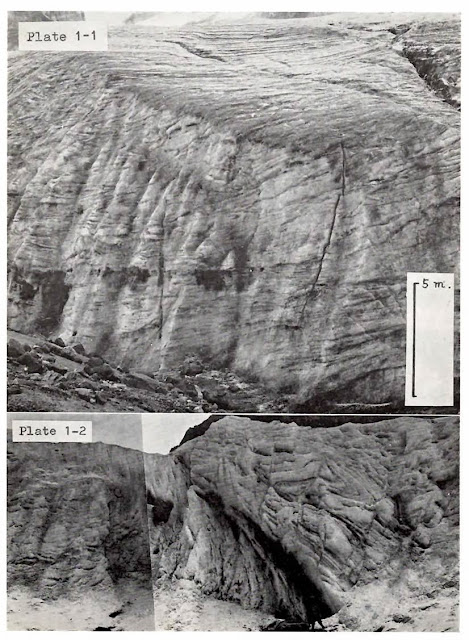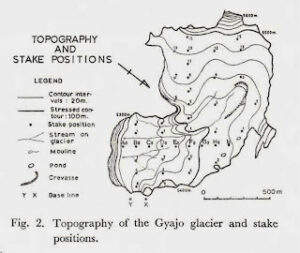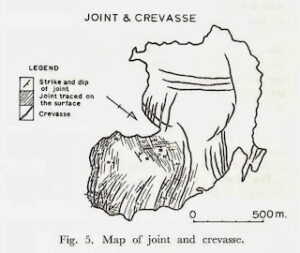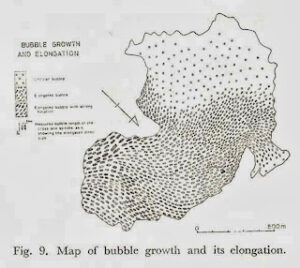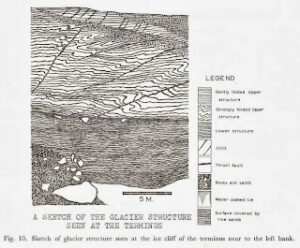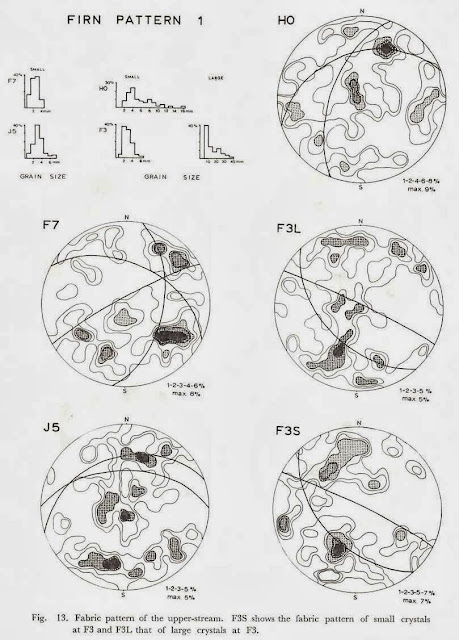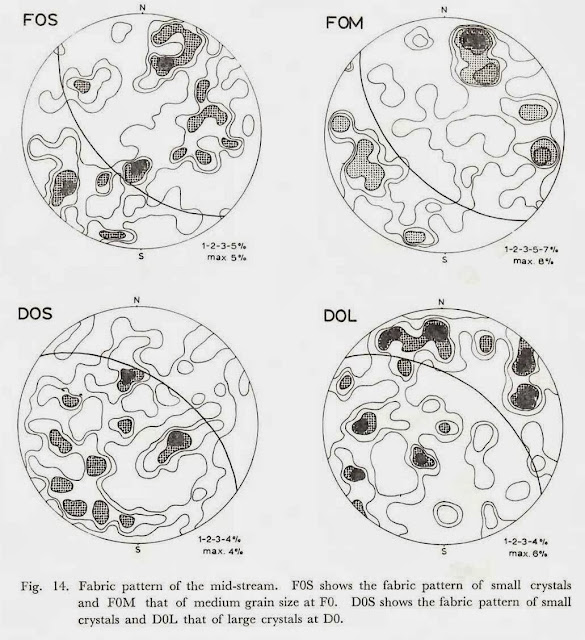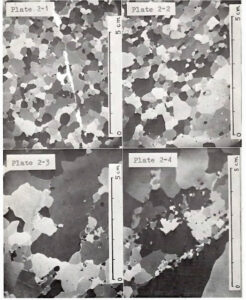ギャジョ氷河 Structural studies on Gyajo Glacier in Khumbu region, east Nepal
本報告では、東ネパールのクンブ地域にあるギャジョ氷河の構造に関する下記論文から、現地調査の結果をまとめた前半部分を紹介します(実験的研究の後半部分は省略)。氷河上流部分に降った雪が氷河氷になり、氷河流動の過程で、氷河の構造がどのように変化(変成)するのかを調べた。世界の山岳地帯で見られる片麻岩などの変成岩の構造との類似点は、岩石や氷河研究者が従来から注目している。
参考文献
ON PREFERRED ORIENTATION OF GLACIER AND EXPERIMENTALLY DEFORMED ICE. 1972, JOURNAL OF GEOLOGICL SOCIETY OF JAPAN, 78, 12, 659-675.
Structural studies on Gyajo Glacier in Khumbu region, east Nepal
The present author engaged in the investigations of the structural glaciology at Gyajo glacier in the Solu-Khumbu district of East Nepal from June to December in 1970 (Fig. 1).
The summer monsoon season, which lasts from June to September in East Nepal, brings rain falls to the Himalayan highland below 5400 m above sea level. The rain turns into snow fall above this level. During the season of 1970, the amount of snow accumulation reaches up to 4 m which is ten times that of the other whole seasons approximately. It should be noted that the snow accumulates mainly in the summer season and develops to glacier ice in the Himalayan highland.
The mean temperature during the summer monsoon is about O°C at near the glacier tongue. In day time, the temperature goes up above the freezing point and then the snow thaws. On the contrary, the temperature comes down below the freezing point in night time so that it freezes up the melted water. It is, therefore, clear that there is an apparent difference in the firnification between the Gyajo glacier and the glacier in the polar regions where the snow metamorphoses to ice without melting. The Gyajo glacier should be classified into the temperate glacier.

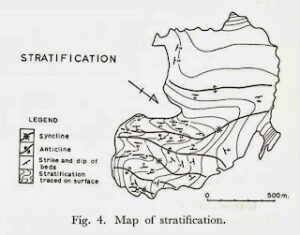
In order to measure the surface flow, forty three stakes were set up and a base line was settled at X and Y points on the left bank of the glacier (Fig. 2).
Bubble foliation is defined by the alternations of bubbly ice and bubble-free transparent ice layer which is strongly developed in the down-stream near the left bank of the glacier (Fig. 3, 6, 9). Stratification is represented by thin layers marked by fine sands, deposited by strong wind which occurs twice a year; once in the pre-monsoon season and the other in the post-monsoan season. There are two kinds of bubble foliation, one of which developed at the upper part of the glacier, has the strike parallel to the flow direction with steep inclination towards the center line. The other occurs at the lower part of the glacier which is able to be observed only at the terminus, and it has not much bubbles but is marked by the thin layers of fine clay and sand which are resulted from the intense shear movement, which brings fine clay and sand out of the bed rock. (Figs. 3, 6, 11).
The structure of the stratification at the upper part in the down-stream shows either gentle or complicated fold system, while it reveals to be intense shear movement parallel to the bed rock to produce the foliation above mentioned at the lower part. Then, joints which signify closed fractures and open to be crevasses, which develop within the upper part of the glacier and hardly cut down to the lower part (Fig. 5, 10). A thrust fault divides the upper part and the lower in the glacier. Consequently, the structure of the glacier is vertically divided into two structural units which should represent the structural levels.
The stratification in the down-stream shows the fold-axes parallel to the flow direction with gentle undulation at the surface, while the acute and complicated fold system such as recumbent and slip folds, develops down to the lower structure (Figs. 4, 6, 10, l l). Furthermore, another fold system, which is partly observed in the downstream, has the fold axis normal to the direction of the glacier flow. Such a superimposed fold system is never seen in the upper- and the midstream (Plate 1).
The average grain size in the upper-stream is 2 to 4 mm and grows to be 70 to 80 mm in the down-stream and 110 mm in the lower structure (Plate 2). The ice crystal becomes especially large near the left bank in the down-stream (Fig. 7). The shape of the ice crystal is not polygonal in the mid- to the down-stream and generally has two elongated directions on the horizonal plane. The strongly elongated direction is parallel to that of glacier flow, but the weak one is normal to the flow direction (Fig. 8 and Plate 2).
In the ice of the upper-stream, fine and circular bubbles are homogeneously scattered but it becomes large and is more elongated toward the down-stream. The elongated direction of bubbles is parallel to the direction of glacier flow (Fig. 9).
The glacier surface in the upper-stream flows six times faster than that in the down-stream does during the summer monsoon season. The maximum flow velocity is 1 18 m y-1 in the upper- stream and 18 m y-1 in the down-stream (Fig. 12).
The locations for measuring the orientation of the crystal axis of ice are F7, J5, H0, F3, F0, D0, B0, B3, F4, and B4 (Fig. 2). F7, J5, H0 and F3 belong to the upper-stream, F0 and D0 to the mid-stream. B0 and B3 belong to the down-stream with weak bubble foliation. F4 and B4 are obtained from the down-stream with strong bubble foliation. Each sample was cut out parallel to the stratification plane. And also the ice samples were cut out horizontally at an ice cliff of the glacier terminus. The ice crystals were divided by the grain size into two groupes; smaller and coarser grains, and the crystal axes of 100 ice grains are measured out of each ice sample. In this report, the orientation diagrams of the crystal axis plotted on the lower hemisphere of SCHMIDT net is called “fabric pattern”. The great circle girdle drawn on the fabric pattern indicates the bubble foliation plane.
In this part, the fabric pattern shows no particular preferred orientation but a great circle girdle is seen perpendicular to the bubble foliation plane at J5 and F3L. The mean grain size is 2 to 5 mm and the texture of ice is generally polygonal (Fig. 13 and Plate 2). The bubble foliation is not well developed.
In this part, the fabric pattern of the coarser crystal grain gives a small circle with several maxima centered at the pole of the bubble foliation (FOM and DOL), but that of the smaller crystals shows the similar pattern to those of the upper-stream which shows the great circle girdle perpendicular to the bubble foliation plane (FOS) . The grain size reaches up to 40 mm (Fig. 14 and Plate 2).

The fabric pattern with weak bubble foliation shows no clear preferred orientation (Fig. 15), but that with strong bubble foliation gives clear preferred orientation with three maxima (Fig. 16). There is a difference between the fabric pattern of coarser grains and amaller ones; the former has strong concentration in maxima (F4L, B4L), but the latter shows the great circle girdle normal to the bubble foliation plane (F4S). The maxima of the pattern from the coarser grain distribute on a smaller circle of which the center coincides to the pole of the bubble foliation plane at location B4. The crystal grain then grows up to 75 mm (Fig. 16).
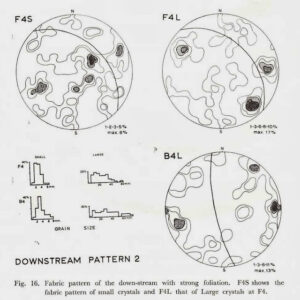 Both of the fabric patterns of the upper structure with complicated fold system and of the lower stmcture, give very strong preferred orientation with maxima. The fabric pattern of the lower structure (TL) has a tendency to concentrate into single maximum on a small girdle of which the center situates at the pole of the bubble foliation plane (Fig. 17). The ice crystals of the lower structure are immensely elongated to be 110 mm along its spindle axis and the crystal texture of fine grains are cataclastic (Plate 2).
Both of the fabric patterns of the upper structure with complicated fold system and of the lower stmcture, give very strong preferred orientation with maxima. The fabric pattern of the lower structure (TL) has a tendency to concentrate into single maximum on a small girdle of which the center situates at the pole of the bubble foliation plane (Fig. 17). The ice crystals of the lower structure are immensely elongated to be 110 mm along its spindle axis and the crystal texture of fine grains are cataclastic (Plate 2).
